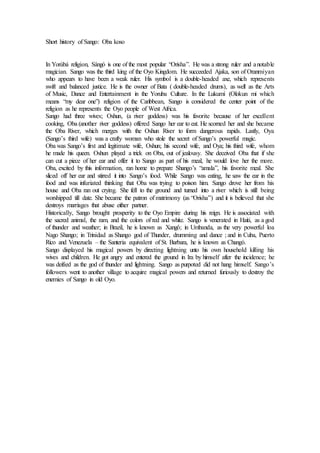Short history of sango
- 1. Short history of Sango: Oba koso In YorÃđbÃĄ religion, Sà ngÃģ is one of the most popular âOrishaâ. He was a strong ruler and anotable magician. Sango was the third king of the Oyo Kingdom. He succeeded Ajaka, son of Oranmiyan who appears to have been a weak ruler. His symbol is a double-headed axe, which represents swift and balanced justice. He is the owner of Bata ( double-headed drums), as well as the Arts of Music, Dance and Entertainment in the Yoruba Culture. In the Lukumà (Olokun mi which means âmy dear oneâ) religion of the Caribbean, Sango is considered the center point of the religion as he represents the Oyo people of West Africa. Sango had three wives; Oshun, (a river goddess) was his favorite because of her excellent cooking, Oba (another river goddess) offered Sango her ear to eat. He scorned her and she became the Oba River, which merges with the Oshun River to form dangerous rapids. Lastly, Oya (Sangoâs third wife) was a crafty woman who stole the secret of Sangoâs powerful magic. Oba was Sangoâs first and legitimate wife, Oshun; his second wife, and Oya; his third wife, whom he made his queen. Oshun played a trick on Oba, out of jealousy. She deceived Oba that if she can cut a piece of her ear and offer it to Sango as part of his meal, he would love her the more. Oba, excited by this information, ran home to prepare Shangoâs âamalaâ, his favorite meal. She sliced off her ear and stirred it into Sangoâs food. While Sango was eating, he saw the ear in the food and was infuriated thinking that Oba was trying to poison him. Sango drove her from his house and Oba ran out crying. She fell to the ground and turned into a river which is still being worshipped till date. She became the patron of matrimony (as âOrishaâ) and it is believed that she destroys marriages that abuse either partner. Historically, Sango brought prosperity to the Oyo Empire during his reign. He is associated with the sacred animal, the ram, and the colors of red and white. Sango is venerated in Haiti, as a god of thunder and weather; in Brazil, he is known as XangÃī; in Umbanda, as the very powerful loa Nago Shango; in Trinidad as Shango god of Thunder, drumming and dance ; and in Cuba, Puerto Rico and Venezuela â the Santeria equivalent of St. Barbara, he is known as ChangÃģ. Sango displayed his magical powers by directing lightning unto his own household killing his wives and children. He got angry and entered the ground in Ira by himself after the incidence; he was deified as the god of thunder and lightning. Sango as purpoted did not hang himself. Sangoâs followers went to another village to acquire magical powers and returned furiously to destroy the enemies of Sango in old Oyo.



